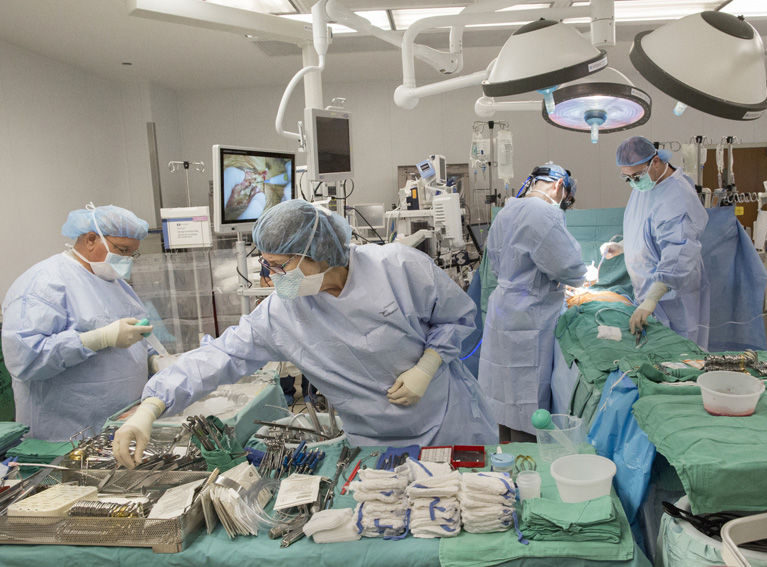
Two Vero Beach cardiovascular surgeons have been busily “pushing the envelope” in heart surgery for the past five years. Dr. Mark Malias and Dr. Cary Stowe have been particularly active when it comes to aortic valve stenosis.
Now Malias, Stowe and other “interventional cardiologists” are attempting to bring a new procedure called TAVR or “trans-catheter aortic valve replacement” to the Vero area. In the TAVR procedure, a replacement valve is inserted through a blood vessel rather than an incision in the chest. It is guided into place and opened with a catheter balloon. The process could make open heart surgery for valve replacement something of a surgical dinosaur.
According to the Mayo Clinic, aortic valve stenosis occurs when, “the heart’s aortic valve narrows. This narrowing prevents the valve from opening fully, which obstructs blood flow from the heart into the aorta and onward to the rest of the body. When the aortic valve is obstructed, the heart needs to work harder. Eventually, that extra work limits the amount of blood it can pump.”
Severe aortic stenosis can even cut off the flow of blood to the brain with a fatal result.
Unlike the other three valves in the human heart, (the mitral, the tricuspid and the pulmonic), the aortic valve cannot be repaired in cases of stenosis. The only viable solution is to replace the valve.
Surgeons have been performing valve replacement surgery since the 1950s, but back then the entire chest cavity had to be splayed open to perform the procedure and that didn not change much for decades.
Both Malias and Stowe were aware that over two million Americans – most of them seniors – suffer from aortic stenosis, so the two doctors started honing their skills and looking for alternative surgical techniques.
They found them.
Long before the term “minimally invasive surgery” became a common catchphrase, Malias and Stowe figured out a way to perform heart valve replacements using an incision only about three or four millimeters long.
As Malias explains, they are “trying to minimize the trauma the body has to go through to be surgically fixed. So, when we don’t have to divide a major bone that’s subjected to bleeding for four hours as we’re doing the operation, we find our patients do better. They recover quicker. They need fewer blood transfusions. They’re able to engage in activities at a much faster rate and overall have a better satisfaction with the procedure.”
How are these new procedures possible?
Malias points to technical advancements in the tools of his trade. “A scalpel,” he says, “is still a scalpel,” but as other disciplines developed new tools, Malias, Stowe and others have adopted and adapted them. For example, Mailias explains, traditional surgical scissors, with a fulcrum point at the center are so big they would fill the entire incision he makes for valve replacement surgery.
Newer scissors, however, have evolved with long thin shafts with the cutting element at the very bottom of the shaft. Those scissors, says Malias, work wonderfully for his procedures.
These procedures also require the use of a heart-lung machine and Malias uses an automotive metaphor to explain why. “I don’t know any mechanic who can change a valve in an engine without turning the engine off,” he states flatly. “You just can’t replace a valve on a running motor.”
So, what do Malias and Stowe use to replace the valves in a human heart? There are essentially two choices: Mechanical or tissue valves. Both have advantages, both have drawbacks.
Mechanical valves are made of high-tech carbon fiber and plastic. For all intents and purposes, they will never break or need replacement. The downside is that patients receiving mechanical valves will need to take blood-thinning medicines such as coumadin for the rest of their lives.
Tissue valves, meanwhile, are made from animal tissue taken from pigs and cows. The big plus for the tissue replacement is that patients do not need to look forward to a lifetime of coumadin. The downside is that tissue replacement valves can and sometimes do wear out. However, Malias says that it’s not the problem it once was, citing a recent article in “The Annals of Thoracic Surgery.”
Perhaps the biggest problem with aortic stenosis, according to NIH is, “most people do not develop symptoms until the disease is quite advanced.” Malias and Stowe know this and actively reach out to local primary care physicians to help them diagnose aortic stenosis early. Without medical intervention fully half of those with the disease will die within two to three years.
Malias points to what he calls the “classic triad” of symptoms: Syncopy or fainting or passing out; Angina or chest pain and shortage of breath. In fact, he says he’s seen some patients with acute stenosis have a cocktail, pass out and blame it on the liquor when a damaged heart valve was the real culprit.
On the other side of the coin, Malias talks about an aortic heart valve replacement he performed just last week on a 92-year-old man. Because of the techniques used, the patient was up and walking just one day after surgery. These two cardiovascular surgeons have now done over 180 such minimally invasive heart valve replacements with similar results.
And, with TAVR on the horizon, the future looks even more promising for Vero heart patients with aortic valve stenosis.
“Some of us,” Malias explains, “are trying to push the envelope and make cardiac surgery better. I think I’m one of them. I hope I am. I’m conservative because of my nature but I don’t want to get complacent, become a dinosaur and die of extinction because I failed to change. I want to think of myself as an early adopter of new things as long as I stay conservative and put my patients’ safety first.”
Dr. Cary Stowe and Dr. Mark Malias are at the Heart Center at 1040 37th Place, Suite 101 in Vero Beach. 772-563-4580.



